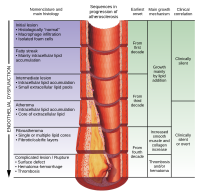
Photo from wikipedia
BACKGROUND There has been no practice-based study regarding the multiphase computed tomography (CT) before endovascular treatment in hemodynamically unstable gastrointestinal bleeding (GIB) and concerns exist regarding the time delay. PURPOSE… Click to show full abstract
BACKGROUND There has been no practice-based study regarding the multiphase computed tomography (CT) before endovascular treatment in hemodynamically unstable gastrointestinal bleeding (GIB) and concerns exist regarding the time delay. PURPOSE To evaluate the clinical efficacy of multiphase CT before endovascular treatment in hemodynamically unstable GIB and to investigate the predictors of angiographic localization and recurrent bleeding. MATERIAL AND METHODS The multicenter retrospective study included 93 consecutive hemodynamically unstable patients who underwent conventional angiography for non-variceal GIB after failed endoscopic localization. Enrolled patients were divided into a CT group (n = 61) and a non-CT group (n = 32). RESULTS The clinical characteristics did not differ between the two groups except for the time to angiography (CT group, 14.8±15.1 h; non-CT group, 9.2±11.7 h, P = 0.022). The rate of angiographic localization was significantly higher in the CT group than in the non-CT group only for lower GIB (P = 0.049). Indirect sign was significantly more frequent in the CT group than in the non-CT group (P = 0.014). CT localization was positive predictor (odd ratio [OR] = 7.66; 95% confidence interval [CI] = 2.1-27.94; P = 0.002) and prolonged time to angiography was negative predictor (OR = 0.94; 95% CI = 0.9- 0.98; P = 0.001) for angiographic localization. A higher systolic blood pressure until index angiography (OR = 0.95; 95% CI = 0.91-1; P = 0.044) was associated with a reduced risk of recurrent bleeding. CONCLUSION In hemodynamically unstable patients, multiphase CT is particularly useful for angiographic localization of lower GIB. It should be considered immediately after failed endoscopic hemostasis to reduce time to angiography.
Journal Title: Acta radiologica
Year Published: 2022
Link to full text (if available)
Share on Social Media: Sign Up to like & get
recommendations!